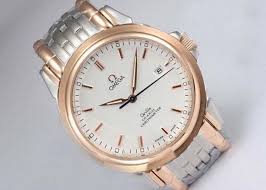Rose Gold Omega Replica Watches Affordable Buy
|
To understand the function of a split-seconds chronograph, it is necessary to first understand how a standard chronograph works. A chronograph is basically a second geartrain that sits on top of the mechanism for telling time. In most chronographs, the wheel that drives continuous seconds is mounted on an axis and a second wheel at the top drives the chronograph. The engagement can be turned on and off just like a clutch. It engages the large seconds hand and the chronograph seconds wheels located in the center of the dial. First apart, then together again A split seconds chronograph can be identified by an extra pusher located on the left-hand side of the case. The chronograph second hand begins to rotate around the dial when the chronograph is turned on. It drives a minute counter which, in turn, drives an hour clock (if there is one). This means that on the dial of a clock,Omega Replica Watches all the information is activated when the chronograph is started. You can read the seconds and fractions by stopping the watch and checking where the large seconds hand is in relation to the smaller divisions. Minute counters, also known as totalizers, will add up the minutes. You get the idea. You have a stopwatch in your watch. Two central chronographs with seconds hands What if you are a racecar or horse driver, or a dissolute aristocratic gambling and want to check the lap time without changing the overall timing of the race? You're out of luck unless you have a separate stopwatch. The Split Seconds Chronograph has a button that is either integrated into the crown or a pusher located on the left-hand side of the watch case. Want to record your lap time? You'll be surprised to see that what you thought was one chronograph second hand is actually running two hands together when you hit this button! Suddenly, they will split apart as Jean Claude Van Damme’s legs are caught between two semis.panerai replica watches The split second hand will stop so that you can record your lap time, while the chronograph's seconds hand continues to move. The hands will jump together again without missing a step if you press the button a second time. This action is one of the most visually stunning in watchmaking, and it's what gives this complication its evocative Gallic name "Rattrapante", or "to catch up."
|
